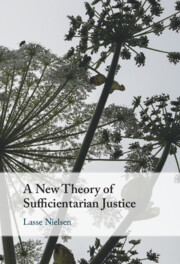Refine search
Actions for selected content:
395 results
Chapter 1 - Sufficientarianism
-
- Book:
- A New Theory of Sufficientarian Justice
- Published online:
- 12 December 2025
- Print publication:
- 29 January 2026, pp 7-37
-
- Chapter
- Export citation
9 - Dementia and the Problem of Speaking for Others
-
- Book:
- Relating to People Living with Dementia as Equals
- Published online:
- 12 December 2025
- Print publication:
- 22 January 2026, pp 168-187
-
- Chapter
- Export citation
1 - Introduction
-
- Book:
- Relating to People Living with Dementia as Equals
- Published online:
- 12 December 2025
- Print publication:
- 22 January 2026, pp 1-7
-
- Chapter
- Export citation
4 - Determining the Authentic Interests of People Living with Dementia
-
- Book:
- Relating to People Living with Dementia as Equals
- Published online:
- 12 December 2025
- Print publication:
- 22 January 2026, pp 69-88
-
- Chapter
- Export citation
Introduction: Disability Equality at the Limits of Life and Law
-
- Book:
- After Disability Rights
- Published online:
- 19 December 2025
- Print publication:
- 22 January 2026, pp 1-16
-
- Chapter
- Export citation
12 - Justice for Less or Justice for More?
-
- Book:
- Justice for Some
- Published online:
- 19 December 2025
- Print publication:
- 22 January 2026, pp 563-596
-
- Chapter
-
- You have access
- Open access
- HTML
- Export citation
8 - Slavery and the Declaration
-
-
- Book:
- The Cambridge Companion to the Declaration of Independence
- Published online:
- 18 December 2025
- Print publication:
- 22 January 2026, pp 109-122
-
- Chapter
- Export citation
7 - Imagine to Re-Imagine
- from Part II - Constitutional Law
-
-
- Book:
- Inter-Asian Law
- Published online:
- 16 December 2025
- Print publication:
- 22 January 2026, pp 130-145
-
- Chapter
-
- You have access
- Open access
- HTML
- Export citation
1 - Introduction
-
- Book:
- Justice for Some
- Published online:
- 19 December 2025
- Print publication:
- 22 January 2026, pp 1-26
-
- Chapter
-
- You have access
- Open access
- HTML
- Export citation
10 - Conclusion
-
- Book:
- Relating to People Living with Dementia as Equals
- Published online:
- 12 December 2025
- Print publication:
- 22 January 2026, pp 188-190
-
- Chapter
- Export citation
6 - The Imperative of Professional Dementia Care
-
- Book:
- Relating to People Living with Dementia as Equals
- Published online:
- 12 December 2025
- Print publication:
- 22 January 2026, pp 111-132
-
- Chapter
- Export citation
5 - The Indirect-First Approach
-
- Book:
- Relating to People Living with Dementia as Equals
- Published online:
- 12 December 2025
- Print publication:
- 22 January 2026, pp 89-110
-
- Chapter
- Export citation
5 - Equality, Liberty, and Rights in the Declaration of Independence
-
-
- Book:
- The Cambridge Companion to the Declaration of Independence
- Published online:
- 18 December 2025
- Print publication:
- 22 January 2026, pp 61-75
-
- Chapter
- Export citation
2 - Diagnosing the Injustices Faced by People Living with Dementia
-
- Book:
- Relating to People Living with Dementia as Equals
- Published online:
- 12 December 2025
- Print publication:
- 22 January 2026, pp 8-39
-
- Chapter
- Export citation
Conclusion
-
- Book:
- After Disability Rights
- Published online:
- 19 December 2025
- Print publication:
- 22 January 2026, pp 187-196
-
- Chapter
- Export citation
Gender and Work Part A: Investigating contexts, impacts, and effects
-
- Journal:
- The Economic and Labour Relations Review / Volume 36 / Issue 2 / June 2025
- Published online by Cambridge University Press:
- 17 December 2025, pp. 306-317
-
- Article
-
- You have access
- Open access
- HTML
- Export citation

Relating to People Living with Dementia as Equals
- Towards Social Justice in Dementia Care
-
- Published online:
- 12 December 2025
- Print publication:
- 22 January 2026

A New Theory of Sufficientarian Justice
-
- Published online:
- 12 December 2025
- Print publication:
- 29 January 2026
6 - The Dangers of Chilling Effects
- from Part III - Implications
-
- Book:
- Chilling Effects
- Published online:
- 20 November 2025
- Print publication:
- 20 November 2025, pp 93-110
-
- Chapter
- Export citation
Discrepancies in the register of primary health care visits: a 6-year time series study from Finland
-
- Journal:
- Primary Health Care Research & Development / Volume 26 / 2025
- Published online by Cambridge University Press:
- 18 November 2025, e95
-
- Article
-
- You have access
- Open access
- HTML
- Export citation
